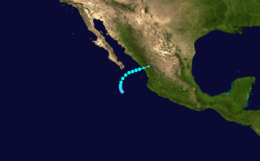Tropical Storm Hazel (1965)
| Tropical storm (SSHWS/NWS) | |
 Track map of the storm | |
| Formed | September 24, 1965 |
|---|---|
| Dissipated | September 26, 1965 |
| Highest winds |
1-minute sustained: 60 mph (95 km/h) |
| Lowest pressure | 986 mbar (hPa); 29.12 inHg |
| Fatalities | 6 total |
| Damage | $10 million (1965 USD) |
| Areas affected | Mexico |
| Part of the 1965 Pacific hurricane season | |
Tropical Storm Hazel was a weak East Pacific tropical cyclone that caused heavy damage in Mexico. The costliest storm of the 1965 Pacific hurricane season, it formed from a northward-moving disturbance that originated southeast of Socorro Island. After reaching tropical storm strength on the Saffir–Simpson Hurricane Scale, the cyclone turned to the east-northeast. The storm made landfall near Mazatlán on September 26 and quickly transitioned an extratropical cyclone. Although fairly weak, the system was responsible for causing heavy damage to the Mexican economy. Flooding in Mazatlán washed out many houses and submerged others in muddy water. At least six people died with damages totaling $10 million (1965 USD) and possibly higher. The name Hazel was retired following this storm.
Meteorological history
On September 22, a weak tropical disturbance was first observed southeast of Socorro Island. The disturbance moved northward uneventfully until late on September 23, when the disturbance became a tropical depression at a distance of 100 mi (160 km). The next day, the depression intensified into a tropical storm while moving north at 8 mph (15 km/h). Later on September 24, satellite imagery suggested winds of up to 50 mph (80 km/h) near the center. Around that time, Tropical Storm Hazel reached its peak pressure of 986 mbar (29.1 inHg). On September 26, a ship reported peak winds of 60 mph (95 km/h). The storm then moved towards the east-northeast and made landfall just south of Mazatlán on September 26 and transitioned into an extratropical cyclone shortly thereafter.[1][2]
Preparations, impact, and aftermath
Since meteorologists were expecting Hazel to remain away from land, many residents were unprepared for the storm. However, 10,000 people fled the low-lying areas of Mazatlán.[3] Substantial damage was recorded in the city[4] Many rivers overflowed its banks, and roughly 5,000 people were without shelter. The entire city of Mazatlán was without power and the city water system was damaged.[5] At least 50 boats were damaged or sunk by the storm. The damage from the storm was estimated to be at least $10 million (1965 USD), making Hazel the costliest tropical cyclone of the season.[1][3] Three people were reported killed in Mazatlán, two fishermen died when attempted to ride out the storm, and a boy who was electrocuted by a downed power line. Three additional deaths from electrocutions were reported in a rural section of Nayarit. Due to a communications breakdown, no word was received about six vacationers in Mazatlán.[4] The city was only reachable by boat.[6] In addition, several shacks made of wood, tin, and cardboard were either washed away or inundated by up to 6 ft (1.8 m) of muddy water while flooding from the storm had washed out bridges and roads throughout the state and some merges were cancelled.[4][7] The cyclone also had a major impact on the coastal economy since Mazatlán's shrimp fleet, which makes up the base of the city's economy. In southern Sinaloa, 55,000 acres (220 km2) of cotton, corn, and sorghum were lost.[4] There were also reports of heavy losses to livestock.[3]
After the storm, 1,000 people were sought shelter in schools; in the farm areas of Barron and El Wailamo, people were taking refuge on top of trees and homes.[3] Army units and relief agencies rushed to provide aid to coastal cities.[5] The name Hazel was retired; the name was replaced with Heather in 1969.[8]
See also
References
- 1 2 United States Weather Bureau (1965). Climatological Data - National Summary. pp. 72–74.
- ↑ National Hurricane Center; Hurricane Research Division; Central Pacific Hurricane Center. "The Northeast and North Central Pacific hurricane database 1949–2015". United States National Oceanic and Atmospheric Administration's National Weather Service. A guide on how to read the database is available here.
- 1 2 3 4 "Storm Damage In Mexico May Exceed $10 Million". San Antonio Express. San Antonio. Associated Press. 1965.
- 1 2 3 4 "Death Count Now 6 In Mazatlan Storm". Tucson Daily Citizen. Tucson. Associated Press. 1965.
- 1 2 "Mexico Battered By Storm". Herald-Journal. Guadalajara. Associated Press. 1965. Retrieved October 30, 2011.
- ↑ "Storm-Hit, Mexicans Get Aid, Coastal". The Spokesmen-Review. Guadalajara. Associated Press. 1965. Retrieved October 30, 2011.
- ↑ "Pacific Storm Batters Mexican Coastal Area". Sarasota Herald-Tribune. Guadalajara. Associated Press. 1965. Retrieved October 30, 2011.
- ↑ Atlantic Oceanographic and Meteorological Laboratory (2009). "Subject: B3) What names have been retired in the Atlantic and East Pacific basin?". Retrieved June 21, 2009.